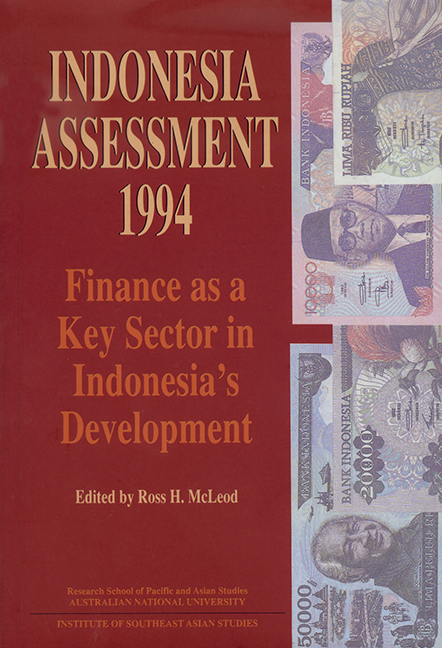Book contents
- Frontmatter
- Contents
- Tables, figures, appendices
- Foreword
- Glossary
- Contributors
- Acknowledgements
- 1 Introduction
- PART A ECONOMIC AND POLITICAL DEVELOPMENTS
- PART B FINANCE AS A KEY SECTOR IN INDONESIA'S DEVELOPMENT
- I The Reform Process
- 4 Financial reform: achievements, problems and prospects
- 5 Comments on Professor Wardhana's paper
- 6 The sequencing of economic deregulation in Indonesia
- II Monetary and Exchange Rate Policy
- III Banking Sector Reforms
- IV Domestic and International Capital Markets
- V Small-scale Finance
- References
- Index
4 - Financial reform: achievements, problems and prospects
from I - The Reform Process
Published online by Cambridge University Press: 21 October 2015
- Frontmatter
- Contents
- Tables, figures, appendices
- Foreword
- Glossary
- Contributors
- Acknowledgements
- 1 Introduction
- PART A ECONOMIC AND POLITICAL DEVELOPMENTS
- PART B FINANCE AS A KEY SECTOR IN INDONESIA'S DEVELOPMENT
- I The Reform Process
- 4 Financial reform: achievements, problems and prospects
- 5 Comments on Professor Wardhana's paper
- 6 The sequencing of economic deregulation in Indonesia
- II Monetary and Exchange Rate Policy
- III Banking Sector Reforms
- IV Domestic and International Capital Markets
- V Small-scale Finance
- References
- Index
Summary
It gives me great pleasure to be here today and to have this opportunity to discuss Indonesia's financial development and prospects. At the outset, let me note that I have taken the liberty of changing the title that was suggested for my presentation, namely: ‘Financial Deregulation Too Much? Not Enough?’. The original title seemed to suggest a simple either/or answer to what is really a complicated set of questions. Although we often use the term ourselves, I felt that it was inappropriate to label what has happened in Indonesia, or in a number of other countries for that matter, simply as ‘deregulation’. A more accurate label might be ‘regulatory reform’.
Some of the early writers in the field of finance and development, such as Edward Shaw (1973) and Ron McKinnon (1973), emphasised almost exclusively the elimination of certain controls as the key to the development of the financial system. They called this process financial liberalisation. Today, we would call it deregulation. But as the experience of several Latin American countries in the late 1970s and the United States’ savings and loan industry in the 1980s have made clear, reforming a financial system is fundamentally a two-pronged process. On the one hand, it involves the removal of direct controls over prices, quantities and activities, combined with an easing of the process that governs the entry of new firms. The result should be that economic choices will be determined mainly through the interaction of market forces. On the other hand, it requires the imposition of prudential regulations that ensure that clear and sufficient information is available to all, reducing excessive risk and minimising opportunities for fraud and manipulation at the expense of the general public.
It is probably correct to characterise the very first steps taken by the Indonesian Government in June 1983 as deregulation. These initial steps consisted of the removal of direct central bank control over the state banks’ interest rates, and over credit allocation by all banks.
- Type
- Chapter
- Information
- Indonesia Assessment 1994Finance as a Key Sector in Indonesia's Development, pp. 79 - 93Publisher: ISEAS–Yusof Ishak InstitutePrint publication year: 1994

